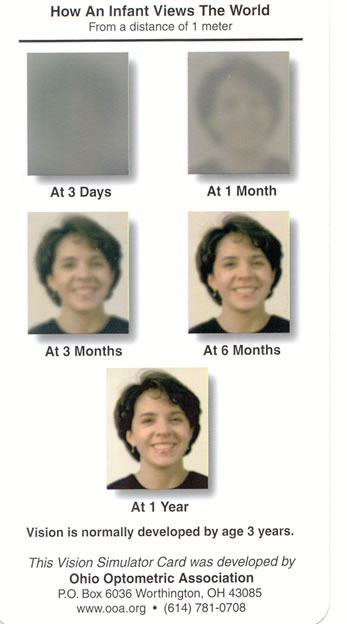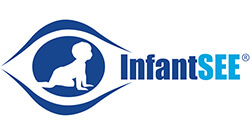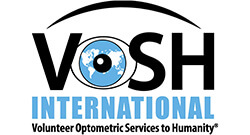What to Look For?
A guide to your child’s visual development from birth to age three
The first few years of a child’s life are critical in the development of good vision. Your baby has a lot to see and learn and will spend much of his or her first years learning how to see. The many different visual skills developed now will serve your child through-out life. Here are a few ways you can help:
The First 4 Months
Your baby sees a world of light and dark patterns. Within the first four months, however, he or she should begin to follow moving objects with the eyes and to reach for things, first by chance and later more accurately, as hand-eye coordination begins to develop.
How you can help
- Change the crib’s position frequently and your baby’s position in it.
- Hang a mobile outside and above the crib.
- Keep objects within your baby’s focus, about 8 – 12 inches.
- Talk to your baby as you walk around the room, giving him or her a target to follow.
- Alternate right and left sides with each feeding.
4 – 6 Months
Your baby should begin to turn from side to side and use his or her arms and legs. Eye movement and control and eye/body coordination skills should develop further.
How you can help
- Allow your baby to explore different textures and shapes with his or her fingers.
- Play patty-cake with your baby.
6 – 8 Months
Both eyes should focus equally now.
How you can help
- Allow your child to crawl and explore.
- Play peek a boo with toys or faces.
- Provide stuffed animals and other objects with details.
- Have older children play in the same room. Your baby will imitate them within the limts of his or her own development.
8 – 12 Months
Your baby should be mobile now, crawling and pulling himself or herself up. He or she now will begin to use both eyes together to judge distances and can grasp and throw objects with greater precision.
How you can help
- Encourage crawling – it is important in developing eye-hand-foot-body coordination.
- Give your baby stacking and take apart toys.
- Provide objects your baby can touch, hold and see at the same time.
1 – 2 Years
Your child’s eye-hand coordination should become well developed.
How you can help
- Help your baby play with building blocks, simple puzzles and balls.
- Provide opportunities to climb and explore indoors and out.
- Provide toys to help develop eye-hand-foot coordination, such as riding toys.
2 – 3 Years
Your two year old will become more interested in exploring his or her environment and in looking and listening.
How you can help
- Read to your toddler to prepare for learning to read.
- Provide tools for drawing, painting and coloring.
- Allow time for outdoor activities.
What Else You Can Do
Watch for symptoms that may indicate a need for professional eye care from an optometrist. These include an eye turning inward, outward, upward or downward frequently or for long periods; favoring one eye; a tendency to bump into objects on one side; red eyes or lids; excessive tearing; encrusted eyelids; or frequent styes. Contact your eye care professional if you notice any of these symptoms and schedule an eye examination.
Infant Vision Simulator


